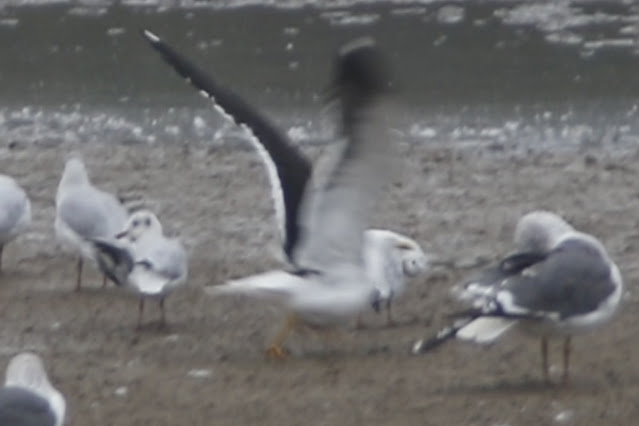A bit of winter sunshine was what the Doctor ordered, but that wasn't what we got every day. Luckily there was still plenty of birds and some sunshine. The wind was quite chilly and I had to put my jumper on a few times 😊
A second-winter Ring-billed Gull had been resident at Salgados Lagoons for a while, so I made this one of my first targets. Luckily it was still present and a Common Gull was hanging out with it. Common Gulls are found only in small numbers during winter in the Algarve.
 |
| Ring-billed Gull |
 |
| Ring-billed Gull |
 |
| Ring-billed Gull |
 |
| Common Gull |
At Portimão fish port up to 100 Glossy Ibis were in residence, which was a first sighting there for me. During the trip I noticed that many were attaining their summer plumage like the one below. At one time I had five Glossy Ibises, two White Storks and a Caspian Tern standing amongst the gulls on a piece of waste ground close to the harbour.
 |
| Glossy Ibis |
One of my favourite places is the mountain Fóia near Monchique. A small area on the north side always produces birds and this time Iberian Chiffchaffs were the stars. I saw a bird that at first glance looked more like a Willow Warbler than a Chiffchaff, but once it started singing I realised it was of course an Iberian Chiffchaff. Note the pale bill and the yellowish wash to the upperparts. Also the supercilium is yellow in front of the eyes.
 |
| Iberian Chiffchaff |
The day on the plains near Castro Verde is always a highlight and we weren't let down this time. A cold north-westerly wind greeted us and caused the long grass to sway dramatically and paint every changing patterns. By the LPN headquarters a Quail was just audible over the sound of the wind and the whispering grass. Lesser Kestrels hunted the steppe and Calandra Larks displayed above us. A distant ring-tail Hen Harrier was good to see, as were ten Black-bellied Sandgrouse, but the much hoped for Great Spotted Cuckoo eluded us.
As we approached the area where a few trees grow a bird flew up and landed on the fence. I new instantly what is was - a Great Spotted Cuckoo. It was quite tame and was allowing me to creep closer. However, a couple of birders approached very quickly as they were driving a car and oblivious to the cuckoo, which they drove past and flushed. This was frustrating as it was a footpath and certainly not designed for driving a car on.
 |
| Great Spotted Cuckoo |
 |
| Great Spotted Cuckoo |
Moving on from the LPN centre we headed for Guerreiro where in the past we have enjoyed good views of Great Bustard. We weren't disappointed as about 30 of these heavyweights were quite close to the track.
 |
| Great Bustard |
A little further along a large raptor flew low over the grassland flushing birds as it went. It was a second calendar-year Iberian Imperial Eagle and amongst the panicking birds were three Little Bustards that flew right past us. Checking the photos I could see that at least two of them had data loggers fitted to their backs.
 |
| Little Bustard |
Lunch was taken at the church on the hill near Monte Salto. The church overlooks much of the area and is a good place for searching the skies for raptors. Whilst enjoying a sandwich Dawn spotted three large birds drifting past and these turned out to be Black Vultures. Three was the same total of Black Vultures I've seen in Portugal ever, but more where to come. I noticed some distant Griffon Vultures and watched them land amongst a gathering of vultures that were feasting on an unidentified corpse. Once satisfied the vultures began to leave and many flew directly past us. Amongst the Griffons were another six Black Vultures.
 |
| Black and Griffon Vultures |
Coastal wetlands and saltpans are very good in the Algarve. On this trip we checked out a few new areas around Vilamoura. The highlight was three Black-winged Kites - all hunting - plus several Marsh Harriers, a Booted Eagle and an Osprey.
 |
| Black-winged Kite |
 |
| Marsh Harrier |
 |
| Booted Eagle |
Good numbers of Avocet were seen at several of the saltpans with 126 at Olháo being the most impressive group.
At the fishing harbours the gulls were far from numerous, but I was pleased to see some colour-ringed
lusitanius Yellow-legged Gulls from the Berlengas Islands. This adult was especially welcomed as normally it is first-winter birds that are seen with rings from this location.



















































